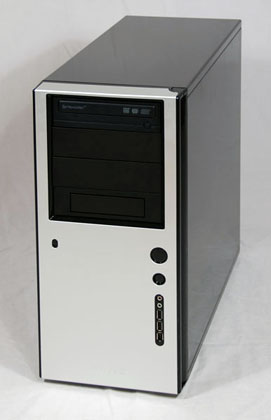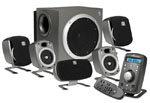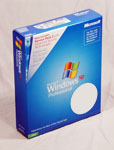


Iím a computer do-it-yourself noob. Sure, Iíve done lots of fiddling with my last two Dells, upgrading video cards, memory, hard drives, optical drives, even a CPU. But Iíve never built a system from scratch. The ease with which Intel Core 2 Duo processors can be overclocked finally convinced me to take the plunge.
In preparation, I spent several months at places like AnandTech, XtremeSystems, SilentPCReview, ExtremeTech, and XBit Labs, pouring over articles and forum threads, learning about components and trends. The objective:


...turn all these...
...into this.
This system is used primarily for gaming. I want to enjoy some of the recent titles with maximum eye candy at 1920x1200. My 4-year-old Dell is falling behind, despite a couple of video card upgrades etc. As I write this, Crysis is yet to be released, but it will be the acid test. I also want to explore the world of over-clocking. Not shooting for extreme benchmark results, but as a means of extending the life of the system.
My other concern is noise. High performance tends to be at odds with quiet computing, but I tried to choose less-objectionable components where possible. Often this boils down to being aware of how much power they use and therefore heat they produce. Some components such as cases, fans, and power supplies have been designed expressly to reduce system noise. The SilentPCReview site has done some great testing from this angle, although you need to combine their results with information from the regular review sites to get an overall feel for a product.
Appearance is a very personal matter. I prefer relatively clean, simple designs. No flashing lights or embedded plastic skulls.
My final concerns are complexity and of course price. Being my first attempt at a DIY system, I wasnít about to venture into water cooling and the like. I also canít afford extreme components to get that last little bit of performance. I look for the sweet spot where dropping down a notch wonít save me much money, but paying more doesnít seem to buy much additional speed. Of course, your sweet spot may differ from mine.
 Processor: Intel Core 2 Duo E6850 3GHz
Processor: Intel Core 2 Duo E6850 3GHz
Since I wanted to try overclocking, the Core 2 Duo family was the way to go. However, I wanted something relatively high in the current range in case my o/cíing skills proved pathetic. For almost the same price as the E6850, I was tempted to get the 2.4GHz Q6600. But until quad cores are clearly demonstrated to make a difference in a variety of games, Iíll stick with the faster dual core. It runs a little cooler too.
 Heat Sink: Thermalright Ultra-120 Extreme
Heat Sink: Thermalright Ultra-120 Extreme
HS Fan: Scythe 120mm 1200 rpm
One of the top-rated heat sinks on many review sites, but its size is likely to prove a tight squeeze. The new Ultima-90 is not yet available, itís a little smaller but with almost the same performance. The Scythe fan is quieter than many others in itís class. I choose the mid-speed model in their range, figuring I could go up or down if testing showed a change was needed.
 Motherboard: Asus PK5-E/WiFi AP
Motherboard: Asus PK5-E/WiFi AP
The P35-based boards seem to offer easier overclocking potential than the 965 and 975 chipsets. The upcoming X38 chipset will likely be even better, but it will probably run hotter than the already warm P35, and it officially only supports the currently-expensive DDR3 memory. No doubt manufacturers will produce DDR2 models too, but could there be future compatibility problems? The Asus PK5-E seems to be a bit better built than some of their cheaper P35 boards. Itís almost identical to the deluxe model, just missing a few features that donít interest me.
The Solo is designed with low noise in mind, including features such as sound-deadening panels and suspended drive mounting. I was tempted to go for Antec's similar Sonata Designer model with its white exterior, but eventually decided to stay with the classic black & silver. The interior is a little tight, and in fact will require a minor mod so my video card will fit. The Antec P182 case offers more room and potentially better cooling, but it has a door. I hate doors. And it looks pretty clunky if you leave it off.
 Power Supply: Seasonic S12 Energy+ 550W
Power Supply: Seasonic S12 Energy+ 550W
The power supply fan can have a big impact on the amount of noise produced by the system. Seasonic is well known for building quiet units. The 550W model has the two six-pin PCI-E video card power cables I'll need. I was tempted to get Seasonic's M12 model with the modular plug-in cables, but this one was a little cheaper.
 Memory: 2GB Corsair XMS2 TwinX 6400C4 4-4-4-12
Memory: 2GB Corsair XMS2 TwinX 6400C4 4-4-4-12
This is an area I know little about. I wanted reasonably good quality memory that could support moderate overclocking and would be compatible with the Asus motherboard. From reading comparison tests and many forum threads, these Corsair sticks seemed like a decent choice, but donít ask me to defend them in detail! Hopefully I'll learn more about memory as I tinker with the system.
While the 8800GTX is not as noisy as some older video cards, this will likely be the loudest thing in my system. But Iím willing to try it to get high gaming performance. There are some ducting mods around that try to manage airflow and reduce temperatures. To fit in, a small notch must be cut in a drive bay of the Solo case. At the time I was buying, the BFG version happened to be cheapest.
 Sound: Audigy2 ZX & Logitech Z680 5.1 Speakers
Sound: Audigy2 ZX & Logitech Z680 5.1 Speakers
Both of these are being moved over from my old system. Good enough for now. (Apologies for using a stock photo, but I wasn't about to unhook the whole kit just for the sake of taking my own shot.)
 Hard Drive: 500GB Seagate 7200.10
Hard Drive: 500GB Seagate 7200.10
Reviews seem to show it as reasonably quick and quiet. Iíll be mounting it in the Solo caseís elastic suspension system which will further reduce the noise. In the future I may add a second drive. I prefer to keep data in a separate partition from Windows and applications, or better yet a separate drive. Then when (not if) Windows crashes badly or otherwise needs to be rebuilt from scratch, my data is more likely to be safe and sound. Besides, it would be cool to say that Iíve got a terabyte in there. What about raid 0? Well, it may win benchmarks, but its minimal real-world gaming advantages donít seem to justify the added complexity. Similarly, I feel fast drives such the Raptor donít offer enough added benefit to justify the extra cost, noise, and heat.
 Optical Drive: Samsung DVD+RW 18x8x16
Optical Drive: Samsung DVD+RW 18x8x16
The Samsung drives are supposed to be quieter than many other brands, but given how inexpensive it is, I wonít be heartbroken if I have to swap it out later.
 Operating System: Windows XP Pro SP2
Operating System: Windows XP Pro SP2
At this point, Vista and DX10 have not proven themselves. DX9 under Win XP is faster with fewer compatibility problems, while DirectX10 has not yet demonstrated that it allows developers to add any really spiffy new "must have" features. Maybe next year Vista will be ready.
The new system will be hooked up to my existing Dell 24Ē 2407FPW (rev. A03) widescreen monitor, running at 1920 x 1200 resolution.
Those are the components I decided would best suit my needs, now it's time to see how they actually fit together.